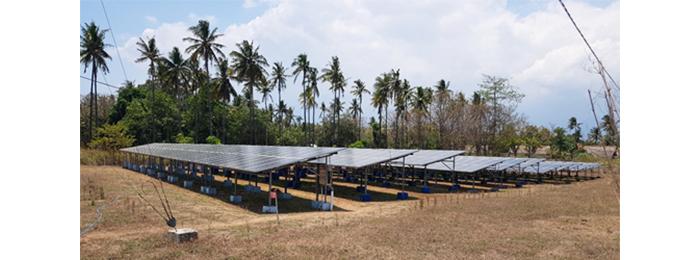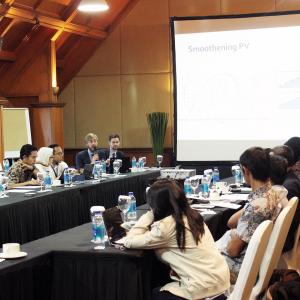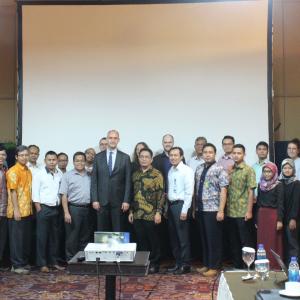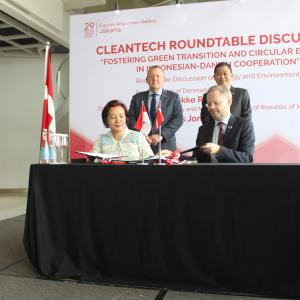Lighthouse of Danish-Indonesian Island-cooperation has great potential for renewable energy
Two recent analyses show that both solar, wind and biomass are competitive technologies on the island Lombok, in Indonesia. Furthermore it is shown that integrating 60% renewable energy into Lombok’s power grid, by 2030, is a cost-efficient initiative. These analyses are a result of the Danish-Indonesian energy cooperation.
The Danish Energy Agency’s country cooperation with Indonesia has led to two new studies on the energy system of Lombok. The work behind the studies consists of contributions by Lombok’s local government and power supply company, the Danish Embassy in Indonesia, Danish consultants and the Danish Energy Agency. Current results of the projects were presented at a conference in Jakarta in December but are now publically available.
The first report – Lombok – Prefeasibility Studies on RE Solutions – consists of a range of studies, showing that solar, wind and biomass are competitive on a private economic scale in Lombok’s energy system. The study is sponsored and implemented by the Danish Embassy in Jakarta in a close relationship with the Danish Energy Agency. It draws to conclusion that burning waste is less competitive under the current ruleset despite the fact that Indonesia is struggling to handle waste treatment.
Read the report "Lombok – Prefeasibility Studies on RE Solutions".
The second report –”Lombok Energy Outlook 2030” – is a system analysis that, among other issues, the most cost-efficient energy mix by 2030 is reliant on 60% renewable energy, when an assumption on externality costs are included.
“Lombok Energy Outlook 2030 shows a promising potential for renewable energy in combination with reductions of local emissions and price-reductions in relation to energy costs for the population of Lombok. We are looking forward to continuing the successful cooperation with our Indonesian partners in the future” says Deputy Director Martin Hansen, Danish Energy Agency.
Read the report "Lombok Energy Outlook 2030".
The Danish-Indonesian energy cooperation
The Danish Energy Agency has partnered with Indonesian authorities on energy planning for years. Through the established energy partnership the Danish Energy Agency supports the green transition on islands and regional energy systems. Hereby, the Danish Energy Agency encourages the implementation of Indonesia’s climate goals on a regional scale. Lombok is the lighthouse in the existing Island-cooperation.
As part of the energy cooperation Danish authorities and consultants assist the Indonesian authorities on the basis of the Danish experience on best practice planning and implementing renewable energy in the power grid, while taking economy, local environment and climate into consideration. Denmark has extraordinary wind resources whereas Indonesia has a more broad selection of energy resources available, such as solar, wind, hydro, geothermal and biomass.
Read more about Danish-Indonesian energy cooperation here.
Fast growing power consumption in Indonesia and Lombok
Power consumption in Indonesia is growing so fast that the expansion of new electricity production can hardly follow the same pace. Security of supply is the dominant first priority in the Indonesia energy system, as absence of power can result in reduced economic growth. Furthermore, Indonesia is home to large coal reserves that can seem appealing to government to produce local jobs. Therefore the coal price is artificially held down and the Indonesian government is planning to expand the power capacity by 35 GW of coal plants in order to ensure the security of supply for the population and industry.

Figure 1: Lombok’s power usage has been doubled since 2011 and is expected to double once more toward 2030 (left figure). Right figure shows daily power usage- and production in the 2030-scenario with external costs and market price of coal. It is seen how integrating large shares of solar power while balancing through Lithium-ion battery storage.
Lombok has a population of 3.5 million, and yet only has a peak power consumption of 260 MW. In comparison, Denmark has a peak consumption of about 6000 MW, and hereby a max consumption about 14 times larger pr. Capita, which is also the case for the average Dane’s annual power consumption compared to average Lombok resident. While the Danish power consumption has been constant these recent years the power consumption in Lombok is expected to double towards 2030, as it also doubled from 2011 to today.
Background
The programme of Strategic Sector Cooperation (SSC) between Denmark and Indonesia started in 2016 and is a close partnership between the Ministry of Energy and Mineral Resources of the Republic of Indonesia (MEMR) and National Energy Council (NEC). The aim is to support development of policies, strategy and solutions expanding the electrification while reaching the long-term goals on renewable energy and energy efficiency.
The two projects on Lombok are co-produced in cooperation between NEC, the local Lombok government, Lombok’s local share of the power supply company (PLN NTB), Ea Energianalyse, KPMG, the Danish Embassy in Jakarta and the Danish Energy Agency.
Contact:
Advisor Loui Algren, +45 3395 4350, loa@ens.dk
Advisor Marievi Vestarchi, +45 3392 6747, mev@ens.dk



